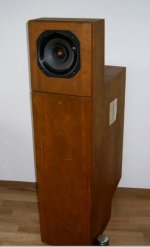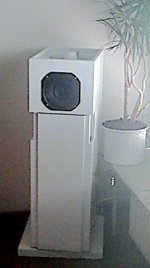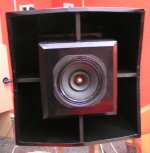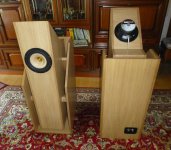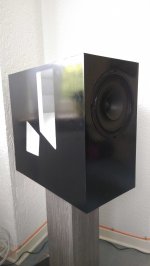Enclosure design for the PS220-8?
Hi all,
I was hoping from some input from those of you who have experimented with these. I am planning on building some MLTL or TQWT cabinets for the pair I have currently in some OB's. The MLTL would be easier to build, but I am not against cutting some angles on boards to do the TQWT or other design. I do like the sound of the TQWT's I was experimenting with some small full range drivers last year and built a set out of scrap wood to experiment with, however I have never tried building a MLTL so can't objectively compare.
I am using them in an approx. 12'x22' living room as the main channel for the A/V system.
Right now I am leaning towards the MLTL option as it seems to be a well documented design.
Thoughts?
Regards,
Nate
Hi all,
I was hoping from some input from those of you who have experimented with these. I am planning on building some MLTL or TQWT cabinets for the pair I have currently in some OB's. The MLTL would be easier to build, but I am not against cutting some angles on boards to do the TQWT or other design. I do like the sound of the TQWT's I was experimenting with some small full range drivers last year and built a set out of scrap wood to experiment with, however I have never tried building a MLTL so can't objectively compare.
I am using them in an approx. 12'x22' living room as the main channel for the A/V system.
Right now I am leaning towards the MLTL option as it seems to be a well documented design.
Thoughts?
Regards,
Nate
Check out the the design in the provided link. Kurt, was one of the first people i know to have designed and built a MLTL with this driver. I think he had it going on with his work, and they sounded pretty amazing!
Mac
speakerdesignworks.com/Singularity_2.html
Yes, I have reviewed these and they do seem excellent for the fact they are a simple design.
Dayton PS-220 and the PS-180
Please excuse this entry on the Dayton PS-180 rather than the PS-220 but, I.M.H.O., it's six of one and half a dozen of the other, unless it's being used as a full range. In that case, I would think the 8 incher would yield a better low end.
The link given is to the parts Express Project Gallery where all the details of that project are given. I might also point out that I was somewhat concerned by the 10 to 15 dB rise in response of the driver when measured outside although it isn't that far off from the 10 dB rise above about 4 khz as seen in the Dayton response curves. The actual response as measured in the room is considerably flatter due to heavy drapes, a plush sofa and armchair and wall to wall soft carpeting.
Prior to buying the PS-120, consideration had been given to the PS-220 but sinceb the system is bi-amped at 200 hz, bass reaponse wasn't necessary.
Consideration had been given to other drivers also, like the Tang-Band 8 inch units, W8-1808 and W81772 but the cost couldn't be justi8fied at the time despite the flatter high frequency response, which, in all probability would have drooped down due to the acoustics of the room. I may still make purchase of the Tang-Bands.
I do a lot of experimenting with speakers; that started in the 70's. There are currently 3 audio systems in the house with six speaker systems. I live alone; that's how I'm able to get away with such eccentricities.
Anyway, here's the link. I hope the information there proves useful.
Robert
Grumpy’s Project | Parts Express Project Gallery
Please excuse this entry on the Dayton PS-180 rather than the PS-220 but, I.M.H.O., it's six of one and half a dozen of the other, unless it's being used as a full range. In that case, I would think the 8 incher would yield a better low end.
The link given is to the parts Express Project Gallery where all the details of that project are given. I might also point out that I was somewhat concerned by the 10 to 15 dB rise in response of the driver when measured outside although it isn't that far off from the 10 dB rise above about 4 khz as seen in the Dayton response curves. The actual response as measured in the room is considerably flatter due to heavy drapes, a plush sofa and armchair and wall to wall soft carpeting.
Prior to buying the PS-120, consideration had been given to the PS-220 but sinceb the system is bi-amped at 200 hz, bass reaponse wasn't necessary.
Consideration had been given to other drivers also, like the Tang-Band 8 inch units, W8-1808 and W81772 but the cost couldn't be justi8fied at the time despite the flatter high frequency response, which, in all probability would have drooped down due to the acoustics of the room. I may still make purchase of the Tang-Bands.
I do a lot of experimenting with speakers; that started in the 70's. There are currently 3 audio systems in the house with six speaker systems. I live alone; that's how I'm able to get away with such eccentricities.
Anyway, here's the link. I hope the information there proves useful.
Robert
Grumpy’s Project | Parts Express Project Gallery
Heh, I happened across this thread today. Turns out I started it!! Whaddya know.
Well my life took a sharp turn right after I posted and started the thread. Whew. <wipes brow>
Wonder what happened to the Decware version of this driver - I think I read somewhere that the results published at the time were, can we say, "optimistic"? But it seemed interesting and was interested to see if anyone played with an approach to render these into a synergistic system.
Personally, they still sit screwed to the rear of those big **** 150Hz tractrix horns!
No movement at all. I eye them suspiciously from time to time. They sit and mock me.
Well my life took a sharp turn right after I posted and started the thread. Whew. <wipes brow>
Wonder what happened to the Decware version of this driver - I think I read somewhere that the results published at the time were, can we say, "optimistic"? But it seemed interesting and was interested to see if anyone played with an approach to render these into a synergistic system.
Personally, they still sit screwed to the rear of those big **** 150Hz tractrix horns!
No movement at all. I eye them suspiciously from time to time. They sit and mock me.
TO: BEAR
Hey, Bear. Love your avatar, cute. I looked up that Decware driver and realized I had seen that site some tim ago but paid little attention tom it at the time. This time, I printed it. Interesting driver. Will have to look up the U-Toob video.
Be careful about how you relate to those horns. If you haven't played them, you'll find out what 5 to 10 watts can do through such a system. I've had more than a casual experience with exponential horns ever since my first of several encounters with Paul Klipsch. I recently designed, yet to build a 125 hz exponential horn for a friend who plays lead and bass guitar. The lead guitar should sound awesome through it. My intent is to power the 12 inch Wharfedale of 1956 vintage with a Grommes 10 watt tube amp. He uses a 500 watt EDEN but I am not going to connect that arc welder to such an old speaker.
How large/long is that tractrix? Mine is 34 inches long not including the driver chamber and opens to a square mouth 36 inches on a side. A phase plug is incorporated in another design.
Hey, Bear. Love your avatar, cute. I looked up that Decware driver and realized I had seen that site some tim ago but paid little attention tom it at the time. This time, I printed it. Interesting driver. Will have to look up the U-Toob video.
Be careful about how you relate to those horns. If you haven't played them, you'll find out what 5 to 10 watts can do through such a system. I've had more than a casual experience with exponential horns ever since my first of several encounters with Paul Klipsch. I recently designed, yet to build a 125 hz exponential horn for a friend who plays lead and bass guitar. The lead guitar should sound awesome through it. My intent is to power the 12 inch Wharfedale of 1956 vintage with a Grommes 10 watt tube amp. He uses a 500 watt EDEN but I am not going to connect that arc welder to such an old speaker.
How large/long is that tractrix? Mine is 34 inches long not including the driver chamber and opens to a square mouth 36 inches on a side. A phase plug is incorporated in another design.
approximately the same dimensions, haven't measured them in years...
what avatar?? That's MY PICTURE!!!
The interesting thing about the Decware is the strange equalization via a transformer secondary, where the primary connects straight through to the load. IF that is what he
is doing.
The questionable part is the very hyper flat freq response that was published back then, I've not been back to look.
(I have a wideband horn system using compression drivers, so I know about them... )
what avatar?? That's MY PICTURE!!!
The interesting thing about the Decware is the strange equalization via a transformer secondary, where the primary connects straight through to the load. IF that is what he
is doing.
The questionable part is the very hyper flat freq response that was published back then, I've not been back to look.
(I have a wideband horn system using compression drivers, so I know about them... )
Please excuse this entry on the Dayton PS-180 rather than the PS-220 but, I.M.H.O., it's six of one and half a dozen of the other, unless it's being used as a full range. In that case, I would think the 8 incher would yield a better low end.
The link given is to the parts Express Project Gallery where all the details of that project are given. I might also point out that I was somewhat concerned by the 10 to 15 dB rise in response of the driver when measured outside although it isn't that far off from the 10 dB rise above about 4 khz as seen in the Dayton response curves. The actual response as measured in the room is considerably flatter due to heavy drapes, a plush sofa and armchair and wall to wall soft carpeting.
Prior to buying the PS-120, consideration had been given to the PS-220 but sinceb the system is bi-amped at 200 hz, bass reaponse wasn't necessary.
Consideration had been given to other drivers also, like the Tang-Band 8 inch units, W8-1808 and W81772 but the cost couldn't be justi8fied at the time despite the flatter high frequency response, which, in all probability would have drooped down due to the acoustics of the room. I may still make purchase of the Tang-Bands.
I do a lot of experimenting with speakers; that started in the 70's. There are currently 3 audio systems in the house with six speaker systems. I live alone; that's how I'm able to get away with such eccentricities.
Anyway, here's the link. I hope the information there proves useful.
Robert
Grumpy’s Project | Parts Express Project Gallery
What was the Dayton woofer that you used?
John
dayton 8" FR horns
i made a few horns which will work with the Dayton driver, as an Satellit and double horn with invers indirect driver, no parts, down 35 Hz, take a view on my HP,
SCHALMEI + HORN SAT, SAXOPHON, RDH20, POSAUNE XL.
i made a few horns which will work with the Dayton driver, as an Satellit and double horn with invers indirect driver, no parts, down 35 Hz, take a view on my HP,
SCHALMEI + HORN SAT, SAXOPHON, RDH20, POSAUNE XL.
Attachments
as mentioned earlier - it will work in a Karlson K12 - - I did not buy the 220 due to Dayton's dismal graph but here's a general report of the characteristics in the 1954 Karlson 12. I would probably use a K15 style/position port and around 12 square inches and trim to taste or measurement (taste can trump measurement as some changes will not show on a graph which affect the voicing of a cabinet - I use bowed and plucked bass viola as one test)
http://www.diyaudio.com/forums/full-range/191302-dayton-8-fr-ps220-discussion-10.html#post2684506
http://www.diyaudio.com/forums/full-range/191302-dayton-8-fr-ps220-discussion-10.html#post2684506
What was the Dayton woofer that you used?
John
Hi John,
The Dayton unit I used is the PS180-8 and is used above 200 hz; it's electronically filtered. The woofers, under the end tables are 10 inch units (#55-2981) purchased from MCM Electronics and load very well in 3 ft^3 with a vent (hole) of diameter = 2.3", assuming 0.75" stock. They have a 2" voice coil and are rated at 250 WRMS. The cabinets are tuned (Fb=36.5 hz) and the -3dB knee, F3=34 hz)
Robert
approximately the same dimensions, haven't measured them in years...
what avatar?? That's MY PICTURE!!!
The interesting thing about the Decware is the strange equalization via a transformer secondary, where the primary connects straight through to the load. IF that is what he
is doing.
The questionable part is the very hyper flat freq response that was published back then, I've not been back to look.
(I have a wideband horn system using compression drivers, so I know about them... )
Hello again, Bear.
I downloaded that info on the DECWARE speaker and I must admit, it is interesting. I too question the ultra flat response which might be 'near field', like 1/4" from the cone in the apex where the response would be quite flat. However, I have not yet delved into that paper as it's going to take some serious reading.
Last edited:
I've done what I think is the Decware trick with a 2.5vct filament transformer - the speaker is in series with the low impedance winding, a 1K pot on the 120 volt winding - there are some reflection effects between the windings within limitations of finite inductances and DCR
- with my Heresy I I could adjust the pot on the fly and adjust the damping and response to some degree and make a solid state amp sound more like a tube amp - in the case of the Decware there's probably a fixed resistor on the high voltage/impedance winding. Decware may still sell their "Gizmo" transformers. A Karlson enclosure should be good and fun for PS220.
- with my Heresy I I could adjust the pot on the fly and adjust the damping and response to some degree and make a solid state amp sound more like a tube amp - in the case of the Decware there's probably a fixed resistor on the high voltage/impedance winding. Decware may still sell their "Gizmo" transformers. A Karlson enclosure should be good and fun for PS220.
I recently did a custom miniOnken for the PS-220.
dave
Has anyone built it ?
I'm trieng to find review as specs of the speaker seems pretty good but i can't find any review
- Status
- This old topic is closed. If you want to reopen this topic, contact a moderator using the "Report Post" button.
- Home
- Loudspeakers
- Full Range
- Dayton 8" FR PS220 Discussion
